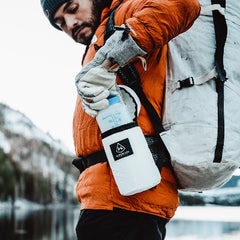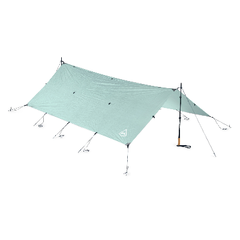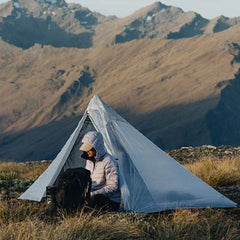Hi, my name is Dave. In September 2010 I completed a thru-hike of the Pacific Crest Trail (PCT). For about 1,300 miles of the hike I used Hyperlite Mountain Gear shelters: the Echo I Tarp and Insert for 650 miles (from Agua Dulce to South Lake Tahoe) and the Echo II Tarp and Beak for 650 miles (from South Lake Tahoe to Ashland). The Echo II was shared with another person for 450 miles. The following is my review of both shelter systems.
Echo I Tarp and Insert
I used the Echo I tarp and insert in the southern California desert and the Sierra Nevada mountains from mid-May to late June (note that I did not have the beak, as the prototype version I was testing at the time was not compatible with a beak). Overall the weather was good for the duration of use, with only a few sporadic showers, one half-inch snowfall, and one night-long drizzle. The shelter did face a lot of wind in the desert and condensation/frost in the mountains.
The Echo I sets up quickly and easily with a minimum six stakes and two trekking poles (or sticks) and can be very easily tightened and adjusted. It is by far the easiest tarp I have pitched in the wind. The catenary cut is excellent and sheds wind beautifully, provided the tarp is pitched drum tight. If it is not pitched tight in breezy conditions, the tarp will make an interesting but rather obnoxious vibrating sound all night long. This was never an issue when pitched tightly. Staking out the guy lines in the center of each side helps prevent this as well, so if you’ll be camping in windy areas, do yourself a favor and carry the two extra stakes (meaning eight stakes in total). This tarp will pull very hard on the stakes, so use something strong, such as MSR Groundhogs or 9” Easton Aluminums. The tarp comes with linelocks for each guy line, which I really liked, as they make tarp adjustment incredibly easy. If linelocks are not your thing, they can be easily removed.
As far as coverage, the tarp by itself covers one person with gear well enough to stay dry in a light or moderate storm, especially if the beak is used, but plan to get damp in a wind-driven rain. The tarp by itself would work great with a bivy sack. Using the tarp with the insert provides much better weather protection, stops the wind almost completely if pitched right, and protects better against pooling water than many tents. The insert is designed to fit no more than one person, so bringing gear inside is pretty cramped but possible. Gear stuffed under the tarp outside the insert will probably get damp or wet, unless it is placed under the beak. If stormy weather is likely, I would highly recommend using the beak, which will protect the user from getting soaked if the wind changes direction (without it, I felt somewhat vulnerable, as the user’s head is not far back from the end of the tarp and the door at the head of the insert is mostly mesh). I never had condensation issues under the tarp with or without the insert, although air flow was noticeably better without it.
One minor issue I did have involved the foot of my sleeping bag getting wet due to a very light drizzle drifting in through the mesh at the foot end of the insert, despite my having pitched the foot end of the tarp low. While this was not a big deal in the SoCal desert, it would have been a bigger problem had it been in Washington, where I hiked through several consecutive days of 40 degree rain and drizzle and keeping my sleeping bag dry was critical. A couple simple solutions would have prevented this: 1) replace the first foot or two of mesh extending back along the sidewalls from the foot of the insert with cuben, or 2) offer a second beak for the foot of the tarp.
Predictably, what I liked best about the Echo I shelter system is its modularity, which makes it versatile to a range of conditions and personal preferences. I was able to use the two components I had (tarp and insert) in several different combinations to match a variety of conditions (note that the insert by itself can be used as an excellent and durable groundcloth or can be pitched independently as a bug tent or even used as a bivy sack for bug protection in a pinch). Using the beak would allow even more combinations and therefore more versatility. I’ll discuss this a bit more later.
Echo II Tarp and Beak
I switched to the Echo II Tarp in the northern Sierra Nevada mountains along the PCT and carried it until southern Oregon, a distance of about 650 miles, from late June to late July. I switched to the Echo II in part because my girlfriend would soon be joining me on the trail, necessitating a two-person shelter, and in part because I was interested in trying a slightly different style of shelter (larger tarp with a beak but no insert). Weather conditions were good most nights this tarp was used, with some wind and a few sporadic showers being the worst of it. Since the Echo II shelter system is simply a wider version of the Echo I, most of the comments I made for the Echo I also apply to the Echo II.
To date, the Echo II tarp with beak (and without the insert) is my favorite three-season shelter for one person, provided bugs are not a major issue. Before the bugs hit, it made the perfect PCT shelter, and a simple lightweight bug bivy would have made it useable in the worst of the mosquito swarms. The Echo II tarp weighs only 1.0 oz. more than the Echo I tarp, provides far more coverage, and sheds wind just as well. For one person there is plenty of room to spread out gear and cook, or to recede away from the edges of the tarp during a heavy storm and stay dry. This also means it has a large footprint, so be sure to have lots of room to pitch. Because of the wider coverage, the tarp can be pitched higher in a storm without fear of getting wet, allowing the user to sit fully upright. For a single person, I do not find the insert or a bivy necessary, and would prefer to use the Echo II tarp with beak and no insert over the full Echo I shelter system (again, provided bugs are not a concern).
For two people, I found the Echo II tarp with beak was adequate if very little severe weather was expected. At 14 oz. (including guy lines but not stakes), it is certainly the lightest two person shelter I’ve carried. Space under the Echo II tarp for two people is about the same as it is under the Echo I tarp for one person, meaning in a wind-driven rain with changing wind direction some part of at least one person is likely to get damp (again, that’s without the insert). Bivy sacks would have been appropriate for this kind of use. Without them, and with the tarp pitched low my girlfriend and I were able to fit comfortably underneath, with gear under the beak, and be fairly confident we would stay dry in a moderate rainstorm with little wind or wind only in the direction of the beak. If I were to use the Echo II for two people in areas with high potential for rain, I would definitely want the insert. After 650 miles of use the Echo II still looks almost new, with no visible signs of wear or damage.
I found that when I pitched the tarp with the beak, it was far easier to enter and exit through the open foot end of the tarp rather than through the beak. This made the zipper on the beak pointless when used without the Echo II insert. To save weight, this zipper should be optional.
For the record, the reason we stopped using the Echo II tarp in southern Oregon was because we were being devoured for weeks by a massive cloud of mosquitos every night (sounds dramatic I know, but trust me, it’s an understatement). This was no fault of the tarp, it was simply time to switch to a shelter with full bug protection. Based on my experience with the Echo I, the Echo II insert would have been fine protection against this.
Why would I buy this shelter?
In my opinion, the major selling point of the Echo shelter system is its modularity, which allows the user varying degrees of protection from the elements depending on his/her preference on any particular night. This will be especially beneficial to tarp users, who tend to like a higher level of exposure to nature when it is safe and practical, but on occasion require a higher degree of protection. For instance, most nights that I pitched a shelter along the PCT (with the exception of Washington), the weather was very predictable and I only needed protection from condensation (pitch just the tarp), mosquitos (pitch just the insert), or a possible light shower (pitch just the tarp with beak). For me, a fully-enclosed tent would have been an unnecessary and unwanted barrier between myself and nature; as such, I really enjoyed the versatile nature of the shelter along the trail. Furthermore, switching between these degrees of protection is very quick and simple—the insert can be pinned up, tarp lowered, and beak attached in bad weather in the dark all in a minute or two.
This modularity also allows versatile use of the gear from one trip to another, which is great for people who don’t want to own lots of different shelters. In other words, the three components (tarp, insert, and beak) compose one complete shelter system, but not all three parts need to be used on every trip, depending on the expected conditions. So while a 22 oz. Tarptent Sublite Sil might be well-suited to rainy Washington, for me it is overkill for simple protection from condensation or a fairly unlikely rainstorm in northern California in July. With the Echo I shelter system, I could carry all three components (24 oz.) in Washington and just the 8 oz. tarp in NorCal, thus adapting a single shelter system to multiple conditions and allowing me to shed unnecessary weight. I think of this as a lot like dressing in layers rather than using a heavy parka while hiking in cool weather.
Other thoughts/suggestions
The following are some additional thoughts on the Echo shelter system:
I would recommend replacing the stock guy lines with something lighter and more reflective.
If I was going to make one suggestion to Hyperlite Mountain Gear, it would be this: offer an optional second beak for the foot end of the tarp. With only one beak, the head end of the tarp (and therefore the entrance) gets pitched into the wind. I don’t like sleeping headfirst into the wind, especially when I have to use the bathroom at night during a wind-driven rain. Having a second beak would eliminate the need to carry the insert in many cases and address concerns over changing wind conditions. Additionally, make the beak zipper optional. If using just one beak, it is generally easier to enter/exit through the open end of the tarp, making the zipper unnecessary weight.
If I was going to make one other suggestion to Hyperlite Mountain Gear, it would be to offer a lighter, cheaper bug bivy. The Echo Insert is a very sturdy and well-constructed piece of gear that is great for storm protection, but too heavy and expensive just for simple bug protection. It would be nice to see an additional insert offered that is fully mesh on the sides, has a lighter bottom, and is intended for bug protection only (which is not really worth the cost of more cuben). For me, a single person lightweight all-mesh bug bivy with a silnylon floor would work great with the Echo II tarp.
This was the first cuben fiber equipment of any kind that I have used. I have avoided cuben in the past because I assumed it had a poor cost to durability ratio, and because I failed to see significant benefits over fabrics like silnylon or spinnaker. However after 650 miles of use on two different cuben products I was sold on the durability (I felt the material was slightly more durable than my old silnylon tarp) and came to appreciate the full waterproofness (no misting), lack of sagging, lack of loud crinkling (compared to new spinnaker), and very taut pitch of the cuben fabric. Whether these factors are worth the high price tag is a personal choice of each individual consumer, so I cannot speak to that.
The post Post-PCT Echo I and II review appeared first on Hyperlite Mountain Gear Blog.


















